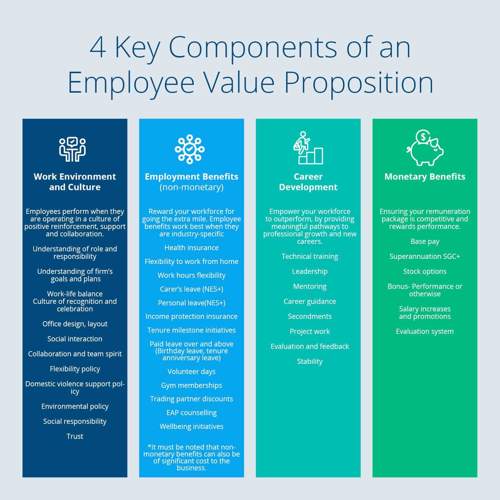The power of the Employee Value Proposition (EVP)!
Recruiting and attracting a workforce has changed dramatically; it is no longer a simple case of “if you have a job, you will fill the position”.
According to a Deloitte’s Accees Economics Report, “…record net migration levels have helped to fill unmet labour demand with job vacancies consistently falling for the past year. Even with the fall, total vacancies remain high suggesting there are still many opportunities in the labour market”. Companies who attract the best talent typically perform well. With many industries continuing to look for both skilled and unskilled workers right across Australia, the question is, how can you attract top talent to your organisation? Or, how can you at least have your organisation stand-out from your competitors? One key strategy to help set your company apart is the development of an enticing Employee Value Proposition. Explore other great strategies to set your company apart.

What is an Employee Value Proposition?
To attract and retain the best talent, it is crucial for companies to develop a strong and relevant Employer Value Proposition (EVP). It’s the “what’s in it for me” from an employee perspective. The type of benefits or value can be broken down into key areas such as work environment and culture, non-monetary benefits, learning and development, and monetary benefits. Your EVP needs to be integrated into your recruitment strategy and digital footprint to ensure its not only reflected in your job postings, interviews, and onboarding processes, but also across your website, social channels, and other digital mediums.
How do you create an Employee Value Proposition?
We have developed four steps to help you create and execute a successful EVP.
Step 1 Understand your organisation and align with company brand:
Reflect on your organisation's mission, vision, and values to pinpoint the aspects of your workplace culture that sets you apart. What are your organisations core values, and what do you stand for? For example, a company that places high value on wellbeing might consider gym memberships or a “wellbeing day” as an essential inclusion. It's also important that your EVP aligns with your overall brand and corporate messaging, as consistency helps further build a strong employer brand.
Step 2: Analyse your current Employee Value Proposition offering.
Conduct a simple survey that asks what employees currently value and what they would potentially like to see included in an EVP. It’s important that the EVP is representative across the demographics of your workforce. Whilst you recognise you can’t be all to everyone, you can ensure that your key audience is considered and accounted for. For example, people with families may prefer work-life balance initiatives such as flexible working arrangements or additional leave day options. Younger people may prefer gym membership or social or team-building events.
Step 3: Compare your Employee Value Proposition with the competition.
You must remain competitive to keep your talent. Comparing your EVP with competitors allows you to benchmark your offerings against industry standards. This also provides valuable insight into what similar organisations provide, helping you to identify areas where you may need to improve or differentiate. Once your EVP is established, a cyclical review should be set up ensuring you stay informed on current market trends and the evolving expectations of employees. Always know your competitor's EVP and if you can’t top it, you need to at least match it.
Step 4: Promote your Employee Value Proposition.
Once your EVP offering is developed, it is vital to let everyone know about it. Ensure that your EVP message is consistent across all communication channels, including your website, social media, job postings, and internal communications. Ensure it is on all your recruitment material, onboarding training, careers pages, and internal & external communications so everyone understands and can talk to what makes your company different. As visual content is often more shareable and can leave a lasting impression, allow some budget to create engaging and visually appealing content to communicate your EVP. This can include videos, testimonials, infographics, and employee stories.
What is a robust Employee Value Proposition framework?
Need some inspiration for ideas to include in your EVP? Explore our example below outlining four key pillars of an Employee Value Proposition and the type of initiatives that can fall under each pillar.

Employees want to feel valued and appreciated. Companies need to offer stand-out perks and benefits that differentiate you from your competitors and add real value to the employee. Your Employee Value Proposition should remain authentic to your organisation's culture and values and ensure that it reflects the organisation’s qualities along with the people that make your workplace unique.
If you want to attract top talent, work with our recruitment specialists to make sure your recruitment efforts are showcasing all your company has to offer. Contact our team today on 13 14 48.
 CA-EN
CA-EN UK
UK AU
AU US
US NZ
NZ PH
PH ZA
ZA SG
SG HK
HK






